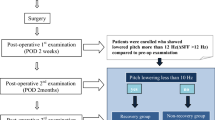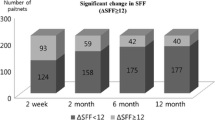Abstract
Background
A lower-pitched voice is one of the most common voice alterations after thyroidectomy without laryngeal nerve injury. The aim of this study was to evaluate the acoustic and stroboscopic changes and the treatment outcomes in patients with a lower-pitched voice with the goal of eventually establishing a therapeutic guideline.
Methods
Patients with a lower-pitched voice were selected according to the results of acoustic analysis among thyroidectomized patients. According to their pitch-gliding ability, patients were classified into a “gliding group” and “nongliding group,” and direct voice therapy was performed. For those who did not respond, indirect voice therapy with subsequent identical direct voice therapy was performed. Video-stroboscopy, acoustic and perceptual analysis, and subjective analysis using a questionnaire were performed before and after treatment. The results of the two groups were compared.
Results
Fifty patients were enrolled. Decreased vocal cord tension was the most common stroboscopic finding in these patients. After direct voice therapy, 87 % of patients in the gliding group showed restoration of pitch 2 months after thyroidectomy. None of the patients in the nongliding group showed improvement. After indirect voice therapy and subsequent direct voice therapy, these nonresponders finally showed improvement 4.5 months after thyroidectomy. Several characteristic stroboscopic findings of the nongliding group were identified.
Conclusions
The pitch-gliding ability and several specific stroboscopic findings were predictive of a response to direct voice therapy. Based on these findings, an individualized therapeutic approach could be applied, and the pitch of patients with a lower-pitched voice after thyroidectomy was restored earlier than expected.






Similar content being viewed by others
References
Sinagra DL, Montesinos MR, Tacchi VA et al (2004) Voice changes after thyroidectomy without recurrent laryngeal nerve injury. J Am Coll Surg 199:556–560
Hong KH, Kim YK (1997) Phonatory characteristics of patients undergoing thyroidectomy without laryngeal nerve injury. Otolaryngol Head Neck Surg 117:399–404
Debruyne F, Ostyn F, Delaere P et al (1997) Acoustic analysis of the speaking voice after thyroidectomy. J Voice 11:479–482
Stojadinovic A, Shaha AR, Orlikoff RF et al (2002) Prospective functional voice assessment in patients undergoing thyroid surgery. Ann Surg 236:823–832
Soylu L, Ozbas S, Uslu HY et al (2007) The evaluation of the causes of subjective voice disturbances after thyroid surgery. Am J Surg 194:317–322
De Pedro Netto I, Fae A, Vartanian JG et al (2006) Voice and vocal self-assessment after thyroidectomy. Head Neck 28:1106–1114
Musholt TJ, Musholt PB, Garm J et al (2006) Changes of the speaking and singing voice after thyroid or parathyroid surgery. Surgery 140:978–988
Van Lierde K, D’Haeseleer E, Wuyts FL et al (2010) Impact of thyroidectomy without laryngeal nerve injury on vocal quality characteristics: an objective multiparameter approach. Laryngoscope 120:338–345
Chun BJ, Bae JS, Chae BJ et al (2012) Early postoperative vocal function evaluation after thyroidectomy using thyroidectomy related voice questionnaire. World J Surg 36:2503–2508. doi:10.1007/s00268-012-1667-0
Aluffi P, Policarpo M, Cherovac C et al (2001) Post-thyroidectomy superior laryngeal nerve injury. Eur Arch Otorhinolaryngol 258:451–454
Nam IC, Bae JS, Shim MR et al (2012) The importance of preoperative laryngeal examination before thyroidectomy and the usefulness of a voice questionnaire in screening. World J Surg 36:303–309. doi:10.1007/s00268-011-1347-5
Stemple JC, Lee L, D’Amico B et al (1994) Efficacy of vocal function exercises as a method of improving voice production. J Voice 8:271–278
Dursun G, Sataloff RT, Spiegel JR et al (1996) Superior laryngeal nerve paresis and paralysis. J Voice 10:206–211
Sabol JW, Lee L, Stemple JC (1995) The value of vocal function exercises in the practice regimen of singers. J Voice 9:27–36
Roy N, Gray SD, Simon M et al (2001) An evaluation of the effects of two treatment approaches for teachers with voice disorders: a prospective randomized clinical trial. J Speech Lang Hear Res 44:286–296
Gorman S, Weinrich B, Lee L et al (2008) Aerodynamic changes as a result of vocal function exercises in elderly men. Laryngoscope 118:1900–1903
Vashani K, Murugesh M, Hattiangadi G et al (2010) Effectiveness of voice therapy in reflux-related voice disorders. Dis Esophagus 23:27–32
Selby JC, Gilbert HR, Lerman JW (2003) Perceptual and acoustic evaluation of individuals with laryngopharyngeal reflux pre- and post-treatment. J Voice 17:557–570
Hanson DG, Jiang JJ, Chen J, Pauloski BR (1997) Acoustic measurement of change in voice quality with treatment for chronic posterior laryngitis. Ann Otol Rhinol Laryngol l06(4):279–285
Park JO, Shim MR, Hwang YS et al (2012) Combination of voice therapy and antireflux therapy rapidly recovers voice-related symptoms in laryngopharyngeal reflux patients. Otolaryngol Head Neck Surg 146:92–97
Conflict of interest
None
Author information
Authors and Affiliations
Corresponding authors
Rights and permissions
About this article
Cite this article
Nam, IC., Bae, JS., Chae, BJ. et al. Therapeutic Approach to Patients With a Lower-Pitched Voice After Thyroidectomy. World J Surg 37, 1940–1950 (2013). https://doi.org/10.1007/s00268-013-2062-1
Published:
Issue Date:
DOI: https://doi.org/10.1007/s00268-013-2062-1




